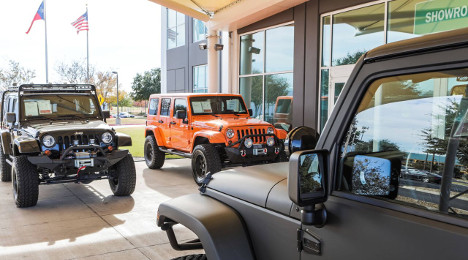EXCLUSIVE: What Vroom is offering dealers

Vroom's Dallas-area reconditioning facility
The arm’s race in the direct-to-consumer and peer-to-peer online used-car space has gotten a spark this year, with big investments, geographic expansion and other growth moves.
So far, much of the buzz has been centered on what these companies are offering consumers.
But one platform, in particular — New York- and Dallas-based Vroom — is now providing its services to dealerships.
Scott Chesrown — Vroom’s vice president of strategy and business development — explained what this means for the dealer community and gave some additional context on this news shared exclusively with Auto Remarketing.
First, the basics.
The company has built an iPhone and Android app specifically for dealers. Through this app, dealers can sell their vehicles to Vroom, with the same appraisal process as the consumer-facing side of Vroom’s services.
It takes a matter of minutes for Vroom to send a guaranteed-buy bid to the dealer posting the car for sale (Vroom puts the value on the car and makes the bid). Same as the consumer side, the dealer then has a week to decide if they want to accept the offer.
Should the dealer decide to take the offer, Vroom creates a buyer’s order electronically. Through the app, the dealer then signs the order with his or her finger, and the money is wired instantly to the store.
But it goes beyond that.
Essentially, there are three components to what Vroom is offering dealers, Chesrown said.
First is the smartphone app, where a dealer scan the VIN and input the information to get an offer on the car while the customer is in the store.
Second, dealers can also utilize Vroom to create a white-labeled “sell your car” page on their websites. It’s basically the service that a consumer finds at www.vroom.com/sell, but branded specifically for the dealership on the store’s website.
The communications to the shopper appear as being from the dealership, but Vroom staff members are actually the ones making the bid, Chesrown said.
“It’s almost like we’re underwriting the appraisal to the consumer,” he said in an interview. “If the consumer comes in and they don’t want to sell their car, they can always sell it to Vroom for the value that we put on it or they can keep it and choose to retail the car.”
Third, Vroom’s system is designed to fully integrate with the dealership’s inventory management.
“So, if they have vehicles that are aging on them, they can click them over with one click into our buyers, and get values on those cars immediately, so that they can have a value seven days prior to taking it to the block and running it, and at least have an idea what a floor and a minimum would be that they could sell it to Vroom directly versus taking it to auction and paying auction fees, etc.,” he said. “It kind of provides a lot of transparency.”
Ten dealers are currently involved in beta testing, and Vroom plans to add more stores to the mix.
Behind the decision to work with dealers
So, why did Vroom decide to offer a product on the dealer side?
The company already had some solid relationships with dealers, Chesrown said. After seeing the Vroom’s work on the consumer side, they asked if the company could do the same for dealers.
“They might have been subscribed to various other programs out there, where it’s more of a lead-gen service and they wanted to see if they could get a foot up in terms of actually providing consumers that visit their sites real cash offers that they can bring into their store and, hopefully, eventually convert into retail transactions, similar to what Vroom does online,” he said.
“So, it kind of started with that little seed … the other piece of it was, since we carry such a large breadth of inventory and it doesn’t matter what type of car it is, we’re always willing to put a number on a car,” Chesrown said.
Vroom likes to “buy any type of vehicle we can get our hands on” to continue building the inventory and a wide selection of vehicles.
“We found that many dealers just continue to pound us with emails and requests for bids for customers that were on their showroom floor (with) cars that they weren’t necessarily planning on keeping or retailing and that might be taken to the auction sometime in the near future,” Chesrown said.
He added: “Here’s an opportunity to maybe branch out a little bit, provide a little bit better service to dealers, so they don’t have to be texting or emailing information over to various connections that they might have at our store, that they can actually go right through on a quick mobile app and input the information right to our buyers and get an instant buy-bid good for seven days right back at them.”
You may notice in the “about us” section of the site, there’s a statement that says “Vroom is making the used-car salesman obsolete.”
In an email follow-up question after the interview, Auto Remarketing asked Chesrown if the new work with dealers was a shift away from that marketing, or if there was another takeaway Vroom would have for a dealer reading that.
“Vroom is looking to make the car buying and selling process much more transparent and consumer-friendly. In that respect, our website messaging refers to how we are changing the current customer experience,” Chesrown said. “There is no change to our approach. Dealers love our easy-to-use appraisal platform and the visibility it gives them on pricing.”
How values are set
Regardless of whether it’s a consumer or a dealer using the product, Vroom examines real-time data in the market to determine the price at which the company can retail (or in some cases, wholesale) the vehicle, Chesrown said. The company then considers what reconditioning and internal costs would be.
“In all honesty, it’s just a very similar way of appraising as CarMax does it,” he said. “We’re not going in with low offers and having the dealer come back to us with a counter-offer.
“We’re really just trying to put the top dollar on the car that we’re willing to pay for it, and in a lot of cases, I think dealers are pretty surprised at some of the values we put on these cars, especially as they get into some very unique cars that might not have a lot of wholesale data or book data on it,” he added.
Auto industry backgrounds
There certainly is some car business experience at Vroom. Chesrown said the foundation of the acquisitions and pricing team is “industry veterans, for the most part” who have been “in and out of the car business but share a very similar mentality to the way that Internet companies are operating today.”
Having these people on board gives the company a wealth of experience when it comes to sourcing inventory and doing so at the right price —and then selling those cars, he said.
That industry background is then combined with the Internet and technology business experience from chief executive officer Allon Bloch, whose background includes leadership of digital platforms Wix (website publishing) and mySupermarket (groceries).
Having leadership with Internet experience and others with auto experience creates “a really unique blend,” Chesrown said.
In July, Vroom announced it had raised $54 million via its Series B funding round.
That followed $19 million raised by Vroom during its Series A equity funding round. Some of that first-round investment was from well-known people with automotive ties: Steve Berrard, the former president of AutoNation and Blockbuster, as well as former football player John Elway, who has also made a name for himself investing in car dealerships.
Next steps
As for what’s on Vroom’s radar, one of the company’s plans, in particular, is to look into how it can develop a marketplace for its select set of stores, Chesrown said.
“We don’t want to necessarily just be in a position where we’re only buying cars from dealers. A lot of times, we have inventory that we might not deem as something that we would want to retail to our consumers, primarily from the standpoint that we don’t sell any cars with a bad Carfax history or a bad AutoCheck history, but they’re still great retail-able vehicles for many dealers out there,” he said.
“So, some of our evolutions are probably going to be making more of our inventory accessible to dealers through the app so that not only can they sell us cars that they’re probably not going to want to keep, but they also have access to cars that they might need.”
The thought behind that, Chesrown said, is that the company buys such a high volume of vehicles on a national basis each day, giving it a “pretty good flow of vehicles into our system, and many of which I think dealers would like to get their hands on before they go to the auction and they have start bidding on them.”
For more information, visit the interest page at www.vroomdirect.com.


